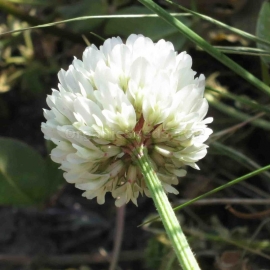
«Berseem» - Organic Clover Seeds
1.14 €
Berseem clover suppresses weeds, prevents erosion, and fixes nitrogen in the soil. Often called the “king of forage” Berseem germinates rapidly, grows quickly, and produces abundant biomass which breaks down to replenish organic matter.
-
Organic Clover «Berseem»
Berseem clover suppresses weeds, prevents erosion, and fixes nitrogen in the soil. Often called the “king of forage” Berseem germinates rapidly, grows quickly, and produces abundant biomass which breaks down to replenish organic matter. Attracts pollinators and other beneficial insects. A green manure crop that does not re-seed in the garden.Bring in Bees!
How to Grow
Soil Preparation
Ladino clover can grow on a wide variety of soils, but does best on fertile, well-drained areas. While ladino can actually handle soils that are more acidic than most clovers prefer, a pH of 6.0 to 6.5 would be perfect.
Soil test prior to planting to determine if agricultural lime is needed to raise the pH. The soil test will also give you the specifics for how much fertilizer to apply. Since clover is a legume, it does not require as much nitrogen unless you are planting it in a blend with a cereal grain like wheat, oats or rye.
When planted alone, clover can be established with 300 pounds of 5-10-15 per acre. Soil preparation is critical to ensure good establishment of this crop. Because the seeds are tiny, a smoothed and light-textured soil will aid in germination and establishment. I normally plow my field first when preparing for clover, but then come over with a drag and cultipacker to firm the soil prior to seeding.
Planting
Depending on your location, ladino clover can be established from August through October. In the northern states, it can also be established as a spring planting in late January through April. Seeding rates of ladino clover can vary from 1 to 5 lbs./acre depending on whether it is drilled or broadcast (drilling allows for lighter seeding rates).
Seed should be lightly dragged or cultipacked after planting to ensure a planting depth of no more than 1/4-inch. A common problem when planting ladino or other clovers is to cover them too deeply in the soil, resulting in poor germination. Prior to planting, seed must be inoculated with the correct strain of Rhizobium bacteria (Strain B).
You can also purchase seed that is pre-inoculated but it will cost a little more. If you do it yourself you can buy a small packet of inoculant from a seed store where you buy the clover. I use a little sugar water mixed with the inoculant in a bucket, and then pour this mixture over the seeds, stirring all of it around thoroughly. Allow the inoculated seeds to dry just a bit before putting them in your spreader.
Follow up
As a perennial, ladino clover will be slow to establish the first fall or spring it is planted. Don’t worry. Keep monitoring, and you’ll see it become very productive the first spring (after a fall planting) and each summer, fall and spring thereafter for as long as the crop persists. Continue to maintain the pH at a level of 6.0 to 6.5.
If ladino clover reaches 10 to 12 inches in height during the summer, it can be mowed to a height of no less than 6 inches to encourage new growth. Fertilize as necessary with a non-nitrogen fertilizer such as 0-20-20 (pull a soil sample and have it tested to determine the exact amount and type of fertilizer for top-dressing the crop).
